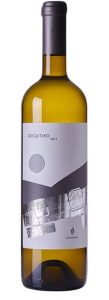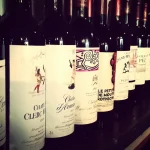This site’s comments section has witnessed a lively debate about what MidWeeker Richard terms WWISM wines (“Why Would I Spend More?).
So, after two Thursday posts concentrating on wines at the inexpensive end of the spectrum, today’s musings unashamedly concentrate on answering Richard’s question.
Indispensable help comes from a widely praised, white, Mediterranean grape variety – Assyrtiko.
Although now also grown on mainland Greece, assyrtiko is probably at its best on the island of Santorini.
A combination of factors come together there to create distinctive and especially intense wines.
Volcanic soil, aged wines, low yields and very limited rainfall all probably have a part to play.
Winemaking there has also received a boost given the help and enthusiasm of folk like Steve Daniel – a top buyer at Oddbins back in the day.
His enthusiasm for Santorini knows few limits.
Jancis Robinson also raves over how the wine “magically combines something saline and mineral with something citrus”, and assyrtiko has won admirers elsewhere.
Versions from other parts of Greece – while not quite matching Santorini options – nevertheless display lively orchard fruit, citrus and other characteristics.
As is normal here, pictures and hyperlinks are provided where possible to guide you straight to the right wine on shelf or web page.
Today’s Approach
We shall start off with a look at an inexpensive option that will allow anyone unfamiliar with the variety to see whether its “direction of travel” suits their specific tastes.
Next, we move up the price ladder a rung to look at wines to see wines that could justify paying a little more.
None of those examples come from Santorini itself although I did recommend one at Christmas time that represents a step or two further up the ladder.
Finally, I have added a final “aspirational” option to illustrate how good wines from that island can get.
First step on the stairway.
2023 Athlon Greek Assyrtiko (£8.99 at Aldi and 12% abv):
This is from the Balkan style Macedonia region, close to Greece’s northern border.
It is lighter and less textured than other examples here.
Pale in colour yet nicely stylish, it has quite light pear, pineapple and melon flavours.
These are neatly combined with lively lemon acidity and suggestions of sweetness within a somewhat creamy depth.
Let’s go up a rung.
2022 Lyrarakis Assyrtiko (from £11.99 at Majestic and 13%).
We move off the mainland to Crete for this example which is one of the richest and most deeply coloured selections here.
Golden in colour and richly textured, the focus here is on crisp apple, apricot and quince flavours.
These are delivered with a lovely clean mouthfeel (but underpinned by seashell savouriness to add bite) and all supported by tangerine acidity.
And another rung
2022 Zacharias Assyrtiko (£12.99 at Waitrose and 14%):
Back from the islands, we head for another important wine region, Peloponnese – not far from Athens.
This is further south than Macedonia and a bit more sweetness seems to surface in the wine but coastal influences preserve “cool climate characteristics” too.
The wine brings us honey edged pear, nectarine and pineapple flavours.
Prickly citrus acidity, touches of lemon curd and a granite backdrop all add welcome embellishments to that foundation.
The final step in this section
2022 Kir Yianni The North Assyrtiko (From £14.98 at The Great Wine Company and 13.5% but a price reduction does seem on the cards):
Here, we head back north to Amyndeo, not that far from the border with Albania, for wine with a little more density.
Slightly fuller than several of its companions here, this contains minty greengage, melon and apple flavours supplemented by lively acidity.
Traces of mint, orange pith and gentle spices complete the picture – along with a background that also has mineral components.
NB:- This may have moved on a vintage by now but remains widely acclaimed
And one can dream
2021 Santorini Barrel Assyrtiko Sigalas (£52.13 at the Great Wine Company and 14.5%):
And so to Santorini itself where low yields do keep prices up and, here, there is an extra premium because the wine is older and has been oaked.
The result is full yet gloriously intricate.
It exhibits viscous and intense peach, ripe melon and mandarin flavours married here to lime acidity.
The vanilla influenced oak hints and extra bonus of camomile and mineral elements add appreciably to its sophistication and complexity.
Call in again on Monday when the spotlight again falls on budget level Top Tips that could be available at a store near you.












24 responses
I love Assyrtiko too. It’s really under appreciated. Wine from Greece and some of it’s near neighbours is often excellent. They are not just better value than some of the more established producers and grapes, they are different in a desirable way.
Along the same lines, Dry Furmint from Hungary and a Pinot Noir from Bulgaria have delighted us recently. I see more of all these now. In the past I would plead with importers to carry such and they would sympathize but refuse on the grounds that it would not sell fast enough. Things are improving and I celebrate that.
The Assyrtiko grapes on Santorini also have to survive the very windy conditions and are grown as unique small low lying bushes in the shape of a knot,very far apart as the “soil” is so nutrient and water poor.The area for vine growing is tiny and getting tinier each year as new buildings are added.
So it is very rare to see Santorini and Assyrtiko on the same bottle label for £17.50 which is the case for the Wine Society’s Exhibition Santorini Assyrtiko 2021 13%.Had very good reviews from Fiona Beckett,Susy Atkins,Victoria Moore,Silver Award by Decanter and 93 points.But it seems to have divided opinion amongst members.
Maybe they see those two magic words and expect the Sistine Chapel of wines?It is true that 10% of this wine is not Assyrtiko and at 50 years old the vines are young by Santorini standards and they are grown on the lower slopes- but I like it.It maybe in the style of Michaelangelo ‘s studio,but as an entry level Santorini it is not at all bad.
We happened upon a Sigalas Assyrtiko over a lunch in a lovely port side taverna in Santorini in 2019. It was absolutley blooming wonderful and if I remember correctly less than €20 a bottle at the time, in a restaurant. Looked to buy some in UK later after we returned and was stunned by the £40+ prices quoted. It is a wonderful winery producing first class wines, but I guess you get what you pay for / have to pay for what you want … I would buy it repeatedly if I could afford it but it is a “very special occasion” wine for me, unfortunately.
Really excellent post, Brian.
In February this year I signed up for one of the “wine events scotland” zoom tastings – “Appreciating PDO Santorini Wines”. The very knowledgeable and enterprising Diana Thompson sent out 6 mini tasting bottles and a Zoom link. The Assyrtiko wines I received had list prices from £35 to £48 per bottle – so definitely in the “Aspirational” category. Frankly I was blown away by the wines, not only were they many rungs up the quality/interest ladder, but the variations between the wines were apparent. Some had oak, some longer skin contact, some small additions of different grape varieties, one was from 120 year old vines etc. For me, if I wanted to splurge £40 on a still white wine, Assyrtiko would be high up on my WWISM list!
However one doesn’t want to drink aspirational wines too often. Recently, I was very happy to relax and enjoy the Athlon Assyrtiko wine at £8.99 from Aldi, as just featured by Brian.
Picking up on Paul’s concern for the future of Santorini, I understand that another factor is the shortage of labour in the vineyards. It is back breaking work and the younger people would rather earn more money for less effort in the burgeoning tourist industry. Perhaps in 5 years time we will fondly remember when one could buy a Santorini wine for a mere £40!
Very much flying blind on both Santorini and Assyrtiko though did have a couple of bottles of Aldi’s original offering when new, several years ago when most stuff they sold was around £4 and they wanted £7 for it. Seemed like a stretch then even though I liked it a lot as I do with any extremes of white wine characteristics that might include salinity, minerality, ”gun powder” etc. that often precludes such wines being enjoyed and readily available in Britain. Try getting hold of Savennieres from the Loire here. It’s more extreme characteristics are not so appreciated especially at current prices for that appellation.
But in respect of the WWISM premise I certainly subscribe these days to spending more for better, even though there will be stuff along the way that disproves that assertion. And then of course we can have better/more expensive at discounted prices so prevalent around today.
I recently took advantage of the Wine Club offering some of its more popular bottles and no typical £7.99 delivery charge reducing a 6 bottle case, usually at £78, down to £36. It included the Black Stump Durif-Shiraz that always amazes me how folks make it a favourite. That’s one I definitely don’t get but their Cabalié does even with variations in vintages over 10 years of enjoying it on and off. There was a cracking Abruzzo Farinelli Pinot Grigio 2023 too, in the order.
But here’s one for appreciatives of the Portuguese Tejo school of production. Lobo e Falcão 2023 is full price £13.99 . What a beauty it is and even probably worth its full price. But at £5.99, yippee! WWISM certainly works.
Thank you Brian. I just love that quality ladder aproach. Keep up the good work
Welcome to the comments section Clarke, good to hear from you. Quite agree that Eastern Europe (which can include Greece at a stretch) offers some of the best quality per pound ratios at the moment. There was a great Furmint (although not completely dry) in the Lidl event I featured last week. Equally Romanian pinot noir is also a regular constituent of posts.
A combination of climate change, temperature controlled fermentation and the spread of best vineyard practice does seem about to spark a change in the countries that appear in wine aisles.
Thanks for the additional information about Santorini. It certainly helps confirm why prices are normally high.
I have not tried that Wine Society example yu mention but their offerings seldom disappoint so it is certainly an option MidWeekers should try.
Great story Alastair for, I think, your first-time post here – always good to hear new voices. I wanted to include that Sigalas oaked version to demonstrate the potential here, even though I know it will not be a regular purchase for very many people!.
Let’s put in context though, few eyebrows would rise at £50 White Burgundy and wine as good as this one can certainly be mentioned in the same breath as many chardonnay superstars.
Thanks Richard – good point about the diversity of the wines. Even the handful of wines featured in this post were pretty varied in style.
Let’s hope, though, that the lure of quality wines will encourage young Greeks to want to help make it – rather than merely serving it to (not always fully appreciative) tourists.
Glad to hear that Richard’s acronym (WWISM) resonates with you, Eddie.
And, a glimmer of hope perhaps, climate change is making Loire chenin blanc better and better so perhaps your Savennieres will have its day even yet.
Good to know that the idea appeals Edwin. I have always liked “Good, better, best” hierarchies but thought it was just my fondness of systems. Surprising how seldom it successfully applies to wine ranges though.
To continue the theme …
Wine Tasting events are great places for finding “wine ladders” to climb.
On Monday evening I attended a Wine Society “Italy Growers – Walk Around Tasting” where 35 wines were available. There were some excellent value sub £10 wines as well as more expensive bottles to try.
I spent some time tottering quite high up on my personal stepladder trying these:
Pinot Nero Reserva Mason, Hofstatter 2020 (£35);
Chianti Classico Reserva, Castello La Leccia 2019 (£25);
Barbaresco, Rizzi Riccio 2020 (£33.50).
What all three of these wines had in common was the complexity of the smell. At first sniff you think this is going to be good! The other thing is that, if you are used to (and, importantly, like) reasonably priced examples of Pinot Noir, Sangiovese and Nebbiolo, respectively, I suspect when you try these you will think wow, I see what all the fuss is about. Personally I have always liked Nebbiolo wines, but this was the first time I tasted one that had such an ethereal quality and oozing elegance and class! A true WWISM moment for me!
And your ticket gives you get 10% off (if ordered within 7 days of the tasting) the price of all wines shown.
Hi Brian & all,
Your comments of Vines growing in extreme conditions on Isla Santorini got me day dreaming of recent holiday visits to Isla de Lanzarote in the Canaries.
After various mainland Spain mediocre offerings from our Hotel wine list we chose a new revelation in Rubicon Seco ( a complex dry white) from Lanzarote itself. A 100% Malvasia wine nurtured in volcanic depressions in the central area to benefit from morning dew. Not readily available & pricey in the UK but much recommended if ever on Lanzarote holidaying sometime soon.
Must be that the harsher you treat a vine the more intense the outcome as noted with the selection today.
Regards to all from our patio in Pennine Yorkshire (first time in 2024 !).
Excellent comment Richard; thank you. I sometimes think that Barbaresco reflects the authentic nebbiolo characteristics better than Barolo but without the hype.
The broader point you make chimes well with an approach I want to explore on this site. Get a sound but inexpensive version of something and one at a 50% higher price and open them together. Works best with, say, a quartet of people interested in wine but can be a couple – with the assessment spread over two days. Sip-for-sip tastings (two separate glasses each) are the best way to assess wine in my view. No real previous experience necessary.
May the sun continue to shine on that Pennine patio.
It is often said that the harder the vine has to work to get a foothold and to get water the better the eventual wine. Counterintuitively, vines in fertile ground put all their effort into growing foliage etc rather than into the grapes. Pity Lanzarote are so expensive here though.
It seems minds up here think alike. Tuesday was 19 ‘C .. first time in 7 months on the north east coast. The patio beckoned … glass in hand.
In a nutshell,Brian,it comes down to crappy birds.
Vines that are under nutrient and water stress develop deeper and wider root systems in search of scarce nutrients and water.Typically these conditions are found on poor soils,steep slopes etc.
The plant only has enough energy to produce a limited number of smaller grapes,but for reproduction it needs these grapes to be super flavourable ,sugary and aromatic to attract crappy birds.Better grapes-better wines.
…. and avians with no need for Allbran.
Thank you, Brian, and everyone else for such illuminating contributions. I’ve learnt a great deal today.
Can’t remember seeing anything from anybody about Asda having a 25% off buy 6 bottles that runs until the end of Monday May 6th! I hadn’t seen it mentioned anywhere ….
As with Sainsbury’s similar offer (though the cut off bottle price point is £5.50 at Asda when it’s £6 at Sainsbury’s), there’s a lot of double-dips as the shelf prices on some wines is already reduced.
Old favourites include Extra Special Dao at £5.25 … Original Mateus Rosé £4.31 … Extra Special Chilean Pinot Noir £5.62 and the Wine Atlas Feteasca Regala at £4.50.
The Paul Mas Syrah is an astonishing £4.12 and the excellent Extra Special Touraine Sauvignon Blanc only £5.62.
Happy May Bank Holiday to Brian, and one and all ….
Hi Eddie,
I had noted that you have recommended the Bergerac Eglise Saint-Martin on several occasions! Pleased to announce that your persistence has paid off – it has been picked up by the (wonderful) Jane MacQuitty in today’s “The Best Bottles for the Bank Holiday” feature in The Times.
Another of your favourites – Spätburgunder, Bio, Ruppertsberg 2023 is now available to order from TWS, and a bottle is in my basket. No pressure though. If not to my liking I will assume that 2023 was an off year!
Richard … I flagged up the Tesco Eglise Saint Jaques to Brian last year who then thought it was as decent as I did and put it on here at MWW.
The next thing it turned up out of the blue on another reviewers blog and call me suspicious reckoned that reviewer’s researchers had gleaned our information because on the face of it it wasn’t something that was being widely punted by Tesco to the press… on their bottom shelf … and obscure Bergerac rouge. Just a lucky find by a fan like me for a Dordogne red that was a cheap and acceptable Bordeaux alternative. We make of it what we will.
Took delivery from TWS yesterday for a weekend case of joy that included the Spatburgunder bio Rupertsberg 2023. Been a bit of a wait. Yet to open it but fingers x’d it’s as good as the 2022 that for a top quality PN Burgundy style for under £10 was stunning. Oh … and more half bottles of the enticing Chinon Noblaie Temps de Cerise Cabernet Franc .. gorgeous stuff considering how young … cheers
Yes, it was indeed down to you Eddie – and that is where this Comments section is so useful. The combined efforts of the MidWeekers Tribe ensures we cover many more wines than I can alone.